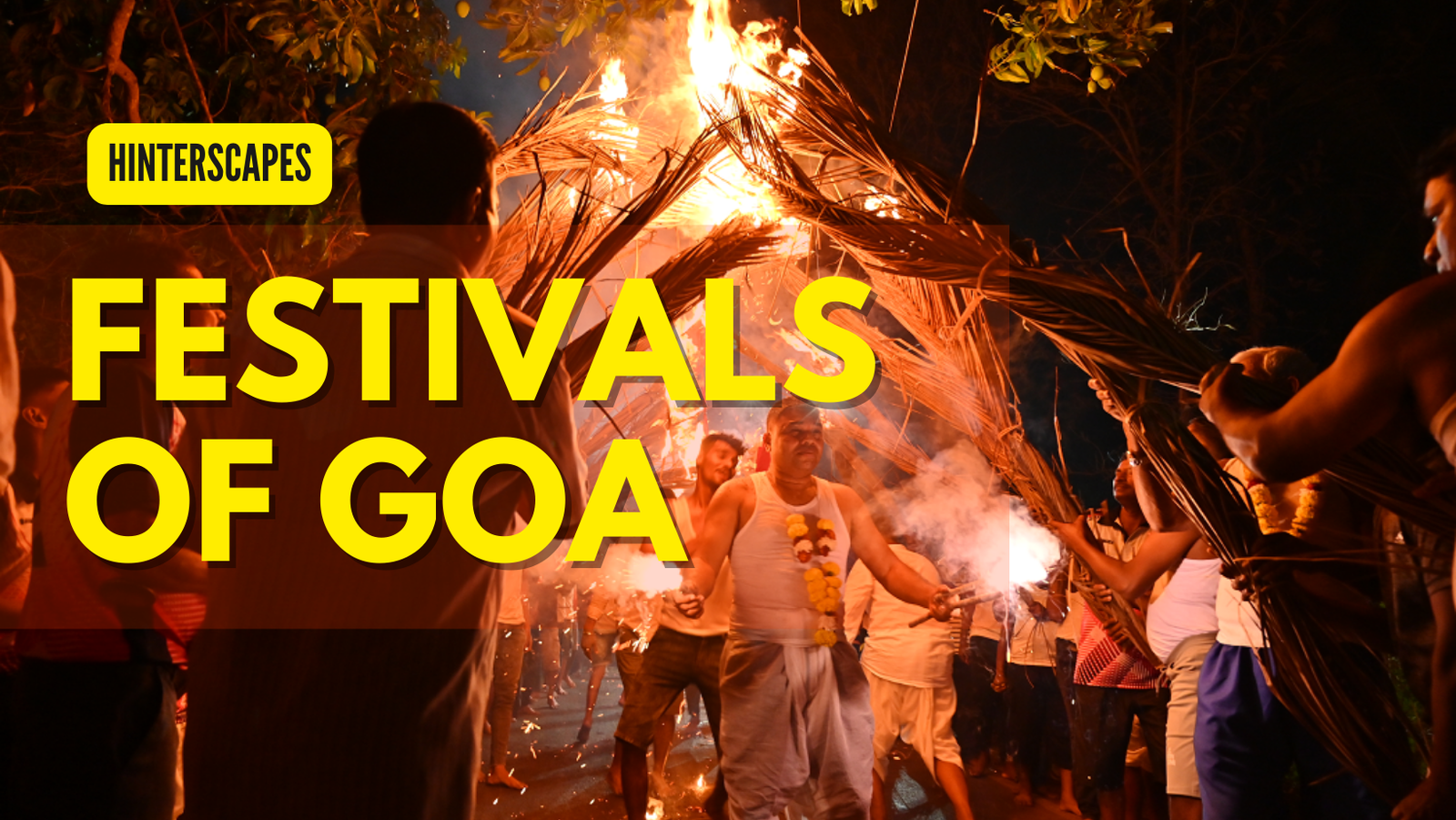Goa, a state located on the west coast of India, has a rich cultural heritage and celebrates a variety of traditional festivals throughout the year. Here are some of the lesser known but unique festivals of Goa that you need to witness at least once in your lifetime.
14 Bizzare Festivals in Goa that will Leave You Thrilled
-
-
Chikhal Kalo or Mud Game in Goa at Marcel ( June-July )
-
Potekar at Diwar Island in Goa ( February-March )
-
Chorotsav in Sattari - Most Exciting Festival of Goa ( February-March )
-
Mussol Khel at Chandor ( February - March )
-
Gadyanchi Jatra in Bicholim Taluka ( April )
-
Sheni Uzzo at Molcornem, Quepem ( February-March )
-
Sao Jao in Siolim ( June )
-
Shisharanni at Canacona ( March)
-
Zagor in Siolim ( January )
-
Lairai Jatra at Sirigao, Bicholim ( April-May )
-
Three Kings Feast at Cansaulim ( January )
-
Makharotsav all over Goa ( October )
-
Bonderam at Divar, Goa ( August )
-
Homkhand at Chorao Island ( March )
-
We will see the significance of each of these thrilling festivals in Goa.
Chikhal Kalo - Mud Festival in Goa
Chikal Kalo (or Chikhalkala) is a monsoon festival that is unique to Goa and celebrated on the grounds of the Devki-Krishna temple in the village of Marcel, located in the Ponda Taluka of North Goa.
Chikhal Kalo is unique to the village of Marcel, here everyone comes together sinking all their differences and celebrate ChiKhal Kalo by singing devotional songs and playing a variety of games. It is believed to have been traditionally celebrated in Marcel as a portrayal of baby Lord Krishna who loved to play with his friends in Vrindavan. The whole scene takes place in front of the Devaki-Krishna temple in Marcel.
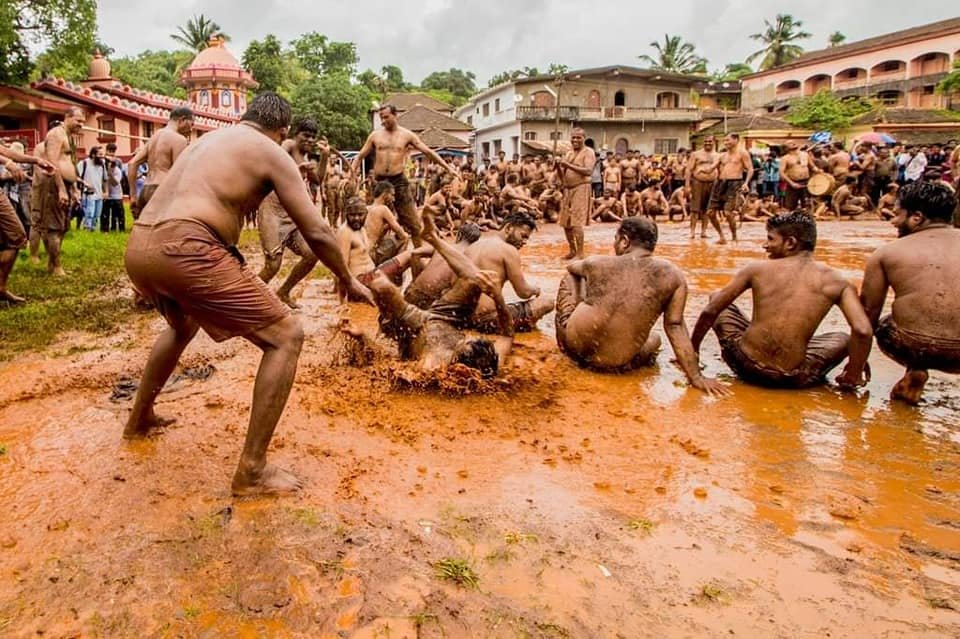
The festival begins with men from the village rubbing oil on themselves. Fun games and activities are then enacted, reminiscent of the games that Lord Krishna used to play with his friends during his childhood. Traditional Goan musical instruments add to the festive atmosphere. Sweets, especially puran poli, are distributed to everyone. The festival culminates with the playing of dahi handi.
Potekar - Famous Unique Festival of Goa at Diwar Island
The Potekar Festival is a unique celebration that originated on Divar Island during the pre-Portuguese era. The festival takes place over three days leading up to Ash Wednesday, and many islanders eagerly participate in it. The Potekar Festival coincides with the Carnival festival, during which King Momo declares three days of fun and merriment.
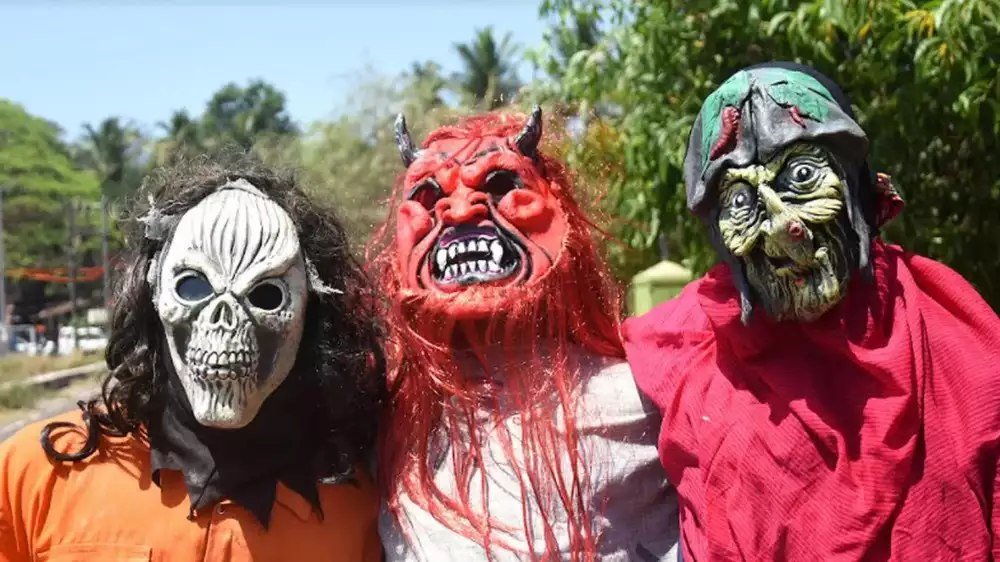
The word Potekar in Konkani means shabby. During the festival, the residents of the island dress up as Potekars and can be seen in every area of the island. The key feature of the festival is the disguise, where individuals dress up in different themes and their identities are concealed for three days. Some even add cowbells to their ankles and waists to create a distinct sound with their getup. To fully embody their new persona, they alter their voice and mannerisms.
Chorotsav - Festival in Goa which Gives You Goosebumps!
The festival of Chorotsav at Zarme and Caranzol in Sattari is perceived differently by outsiders and locals. While the sight of four men buried alive is grim to outsiders, for the locals it is a ritualistic celebration. Chorotsav is celebrated on the seventh day of holi and marked by eight pits dug in a Swasthic pattern, with two poles standing in two directions.
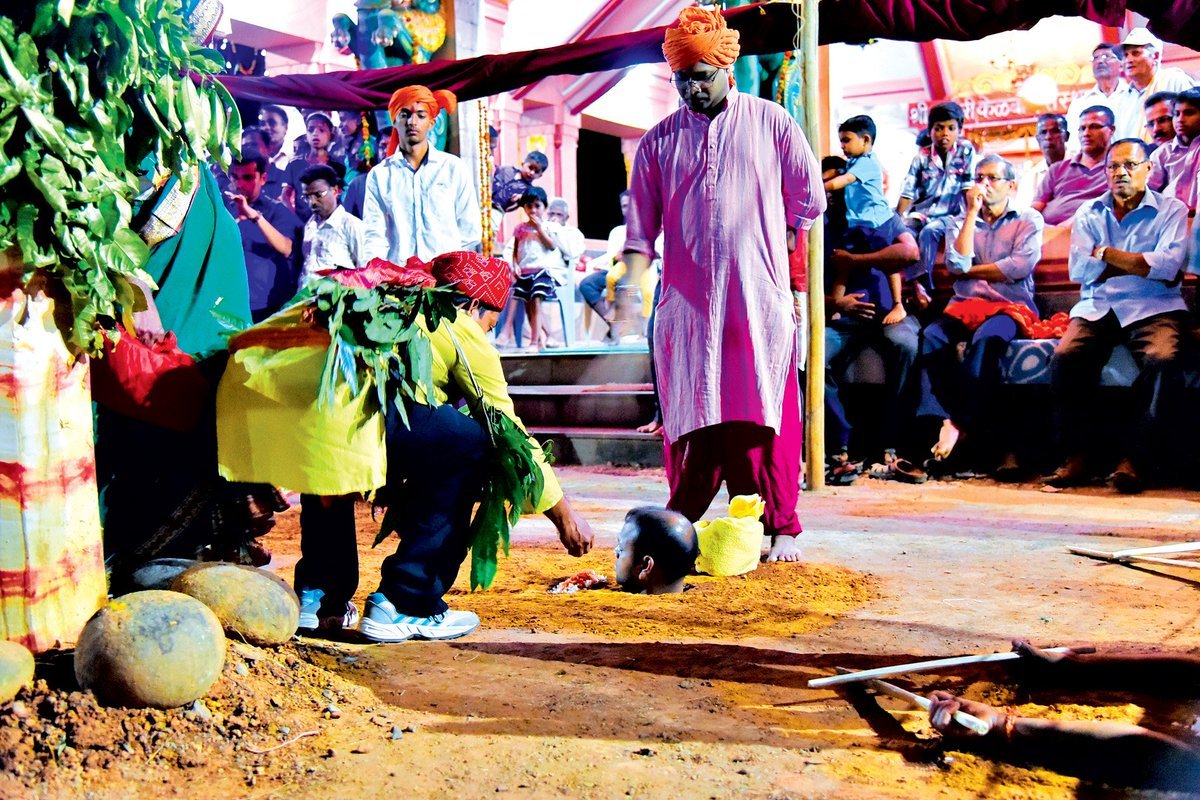
During the festival, four individuals are buried with only their heads popping out, while four others are buried with only their heads buried in the pits. This symbolizes how thieves were mistakenly killed centuries ago. The event attracts a crowd of locals and curious onlookers, who watch with bated breath as the eight individuals are buried alive.
Mussol Khel - Play with Weapons in Goa
Musallam khel or Mussol nach is an ancient dance, that takes place in this village and has been happening for several centuries. A Mussol is basically a pestle and hence the dance translates to pestle dance. It is a pounding pestle dance, presented by the Christian Chardo (Christian Kshatriya) community of Chandor.
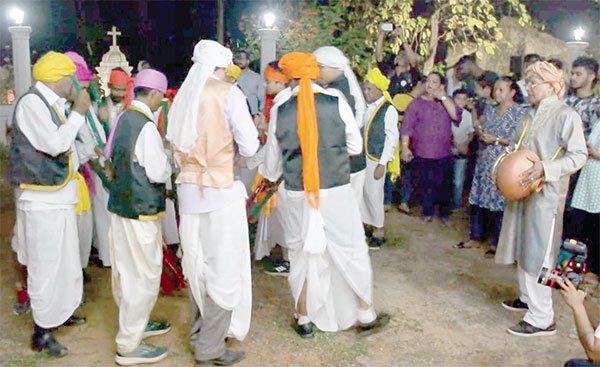
During the dance, people wear a dhoti, jacket, pagdi, and ghungroos, and dancing in a circular movement, holding pestles in their hands. As they move in the circle, the pestles point towards the middle – one step at the back and one in front is the movement of the pestle. Chanting songs, they dance to the beat of ghumot, zanzh and mussol.
Gadyanchi Jatra - Goa's Most Thrilling & Unbelievable Festival
The spring-harvest celebrations of Shigmo in the villages of Sal, Borde-Bicholim, Pilgao, Kudne, and Savai-Verem include a festival that demonstrates gratitude towards ghosts and spirits. This festival, which lasts for three days, honors Lord Mahadev, the God of Ghosts. The highlight of this festival is the jatra that takes place on the night of holi poornima in the village of Sal and attracts a large crowd from neighboring states.
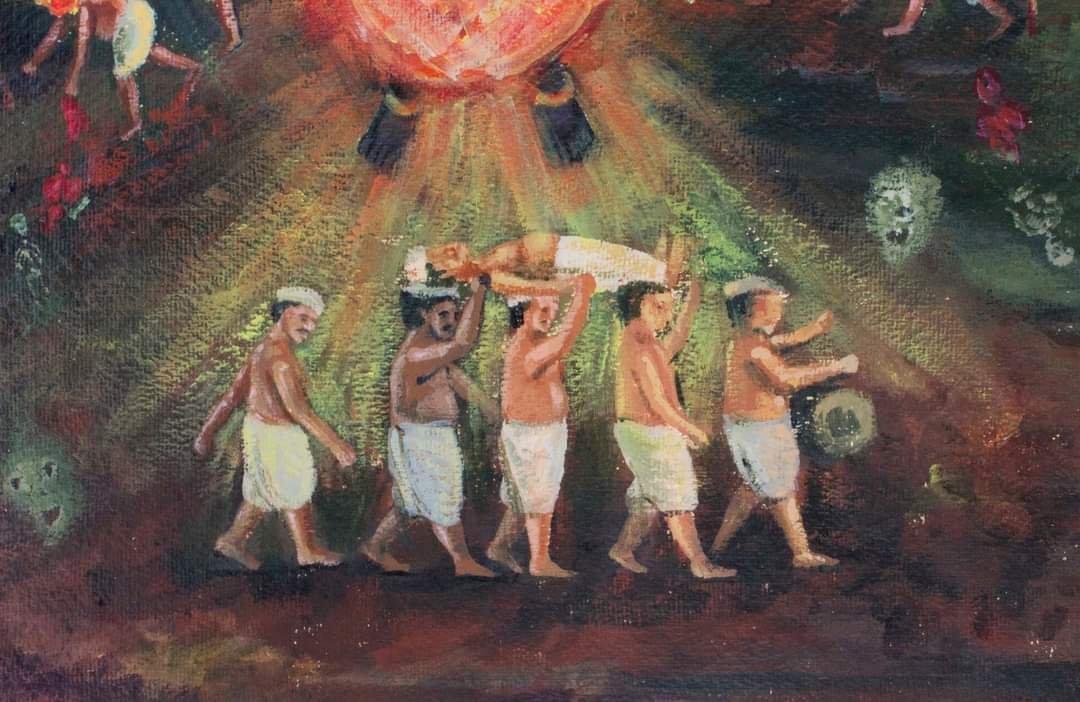
During the jatra, a decorated pole with mango leaves is erected, and men in white dhotis, known as gades, sing and dance around it. On the third day, while the gades are under a trance, a ghost or devchar lures them into the forest with a burning lamp. The ghost tries to deceive them by lighting and extinguishing the fire, and also hides a few gades among the trees. Many people come to witness this mysterious event, and the unconscious gades are revived with holy water.
Interestingly, in the village of Kudne, the same jatra takes place for three days without illuminating any torches or lamps. Despite the absence of light, this mesmerizing festival remains a unique and captivating experience.
Sheni Uzzo - Holi Festival with Fire
In the remote village of Molcornem in Quepem, the festival of Shigmo is celebrated through a unique ancestral ritual called Sheni Uzzo. This ritual pays homage to the village's founding fathers and beliefs. It involves using dried cow dung cakes (sheni) and leaves to create friction and spark a fire(uzzo).
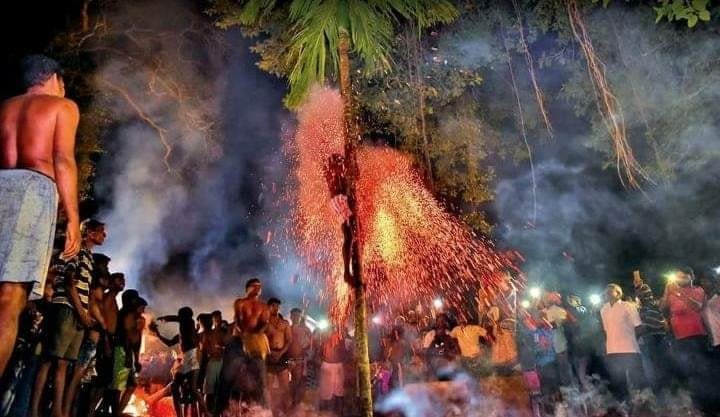
During the spring/harvest season, a festive celebration takes place where the sheni (uzzo) is set alight. Despite the risk of burning embers falling on their skin, the participants remain unbothered as they are focused on the lively energy that the burning sheni generates, which keeps the night alive. This joyous occasion is a way of expressing gratitude towards the spirits and honoring their presence. The celebration is characterized by its remarkable radiance, which adds to the overall sense of gratitude and appreciation felt by those in attendance.
Sao Jao - Goan Festival of Fun in Monsoon
San Joao, a traditional Goan feast, is renowned for its vibrant spirit of festivity, tradition and colour. This annual festival is celebrated with great enthusiasm and energy, particularly in Siolim, where people from various villages come together dressed in colourful attire to gather near a stream on carnival-themed boats and floats.

The history of San Joao in Siolim can be traced back to nearly 150 years ago when devotees of San Joao from villages such as Chapora, Zhor, Badem in Assagao and Siolim would make an annual pilgrimage by boat to the chapel of Sao Joao in Periera Vaddo, Siolim, to pay homage and participate in the customary dali.
Shisharanni - Cooking over Stove Made up of Human Heads
The Shri Mallikarjun Temple in shristhal Gaondongrem, Canacona holds the traditional ritual of Shisharanni every third year during the Shigmo Festival. This ritual involves cooking rice in a unique way, where the cooking utensil is placed on the heads of three men lying on the ground, resembling a traditional cooking place.
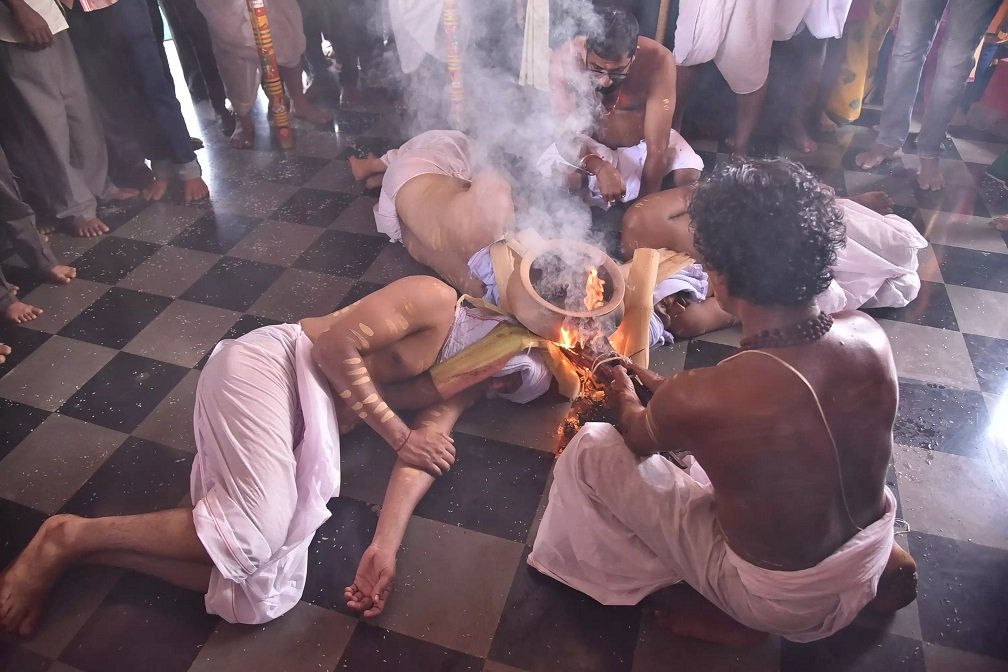
The name Shisharanni is derived from the combination of two words, Shisha meaning head, and Ranni representing a traditional cooking place. The ritual is linked to three gades, who are believed to be humanoid representations of God on earth, for a short period of time. The gades in traditional costumes and sporting turbans lie on the floor with their heads serving as the sides of a makeshift stove. On this stove an earthen pot with rice, human blood and water is placed. Burning logs of shisham are put under it.
Zagor - Traditional Festival in Goa
Zagor, a term used in several Goan villages such as Siolim, Anjuna and Nageshi, refers to the practice of staying up all night to honor the Almighty or the protector of the village. For many villagers, participating in this festival is of great importance, as they believe it will bring protection and prevent potential calamities such as floods or the destruction of bunds due to the nearby Chapora river. Typically celebrated after the harvest season, Zagor is an integral part of the villagers' culture and tradition.
In Goa's Siolim village, the lesser-known Zagor festival brings together Hindu and Catholic devotees. It is a night long religious festival where devotees invoke god throughout the night. The festival is held on the day after Siolim’s Feast of Nossa Senhora de Guia, or the first Monday after Christmas. If you happed to visit Siolim on this day, the scene is of a typical village feast with stalls of flower vendors, sweet shops and even local gambling dens.
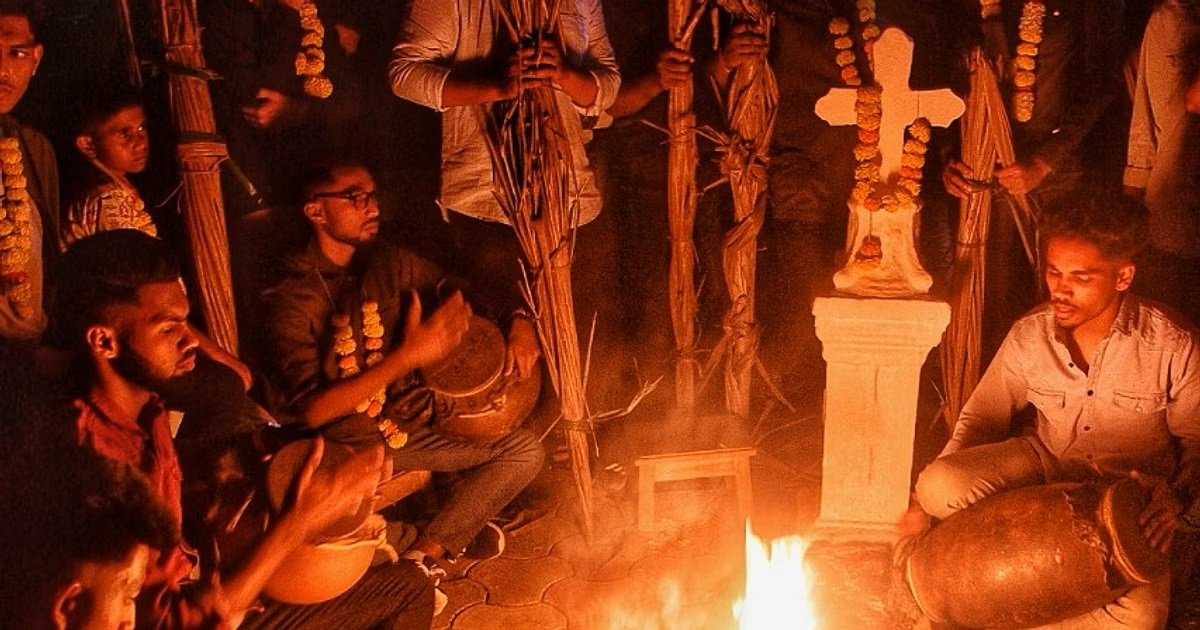
You will be invited to a special dinner made on this day, and the menu will include sanna (bread made of steamed rice). It is a dish made mainly in Christian homes, but on this day, even Hindu homes cook it. You will witness serpentine queues of devotees holding garlands and candles in their hands, which are offered to Zagorio and Our Lady respectively. The main reason that devotees flock here is the special prayer which is locally called sangne. These devotees ask the Almighty to fulfill their wishes, and it is mandatory to make another visit once the wish is fulfilled.
Lairai Dhondachi Jatra - Most Famous Festival of Goa
The Shirgao Jatra is an annual festival that takes place at the Lairai Mandir in Sirgao, showcasing a beautiful blend of northern and southern styles of art and temple design. One of the highlights of the festival is the traditional practice of walking on hot coals, which are raked from a large bonfire, and is considered an act of devotion and penance by the devotees and attracts both locals and tourists.
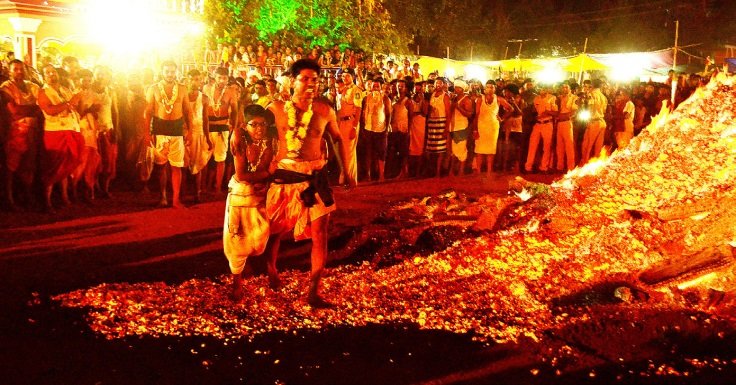
The Shirgao village in Bicholim hosts the popular Lairai Dhondachi zatra, which is an important part of Goa's diverse religious tapestry. During this traditional festival, the village becomes a hub of excitement as tens of thousands of devotees from all over the state and Konkan region gather to participate.
Three Kings Feast - Celebration of Harvest Season in Goa
The Feast of Epiphany, also known as the Three Kings or Magi Feast, is a traditional celebration that takes place on January 6th in the south and north of Goa, specifically at Cansaulim, Chandor and Reis Magos, respectively. This is the final celebration with which the 12 days of Christmas end on January 6. This celebration commemorates the journey of three wise men over 2000 years ago to Bethlehem, where they paid homage to the infant Jesus.
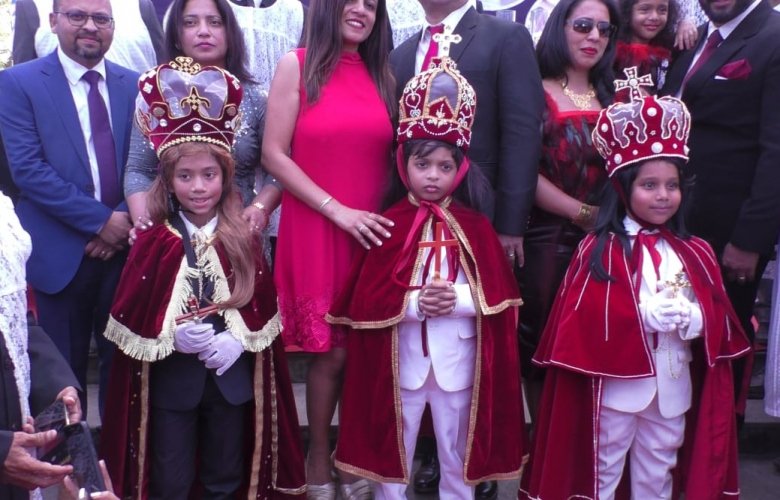
In the village of Cansaulim, three young boys from neighboring villages are selected to play the role of the Three Kings. Riding on horseback, they each take a different path and eventually converge at the chapel of Nossa Senhora dos Remedios (Our Lady of Remedies) in Cuelim. Dressed as kings and carrying the same gifts of gold, frankincense, and myrrh, they participate in a feast mass at 10:30 AM.
Makharotsav - Uniqueness of Navratri in Goa
The nine nights of bright Ashwin which are celebrated as the Navratri, are the important occasions in Goa to express the devotion to the various forms of mother goddess. During the nine nights of Navratri in the most of the temples of mother goddesses in Goa, devotees organises the Makharotsav, which exhibits hidden artistic talents of villagers.
The annual fair or jatra and the nights of Navratri are the two occasions when the presiding deity of the village temple is made to sit in well decorated multi-coloured Makhar having a swing tied to the ceiling of the main hall of the temple with the iron chains, which is swinged to and fro by the devotees.
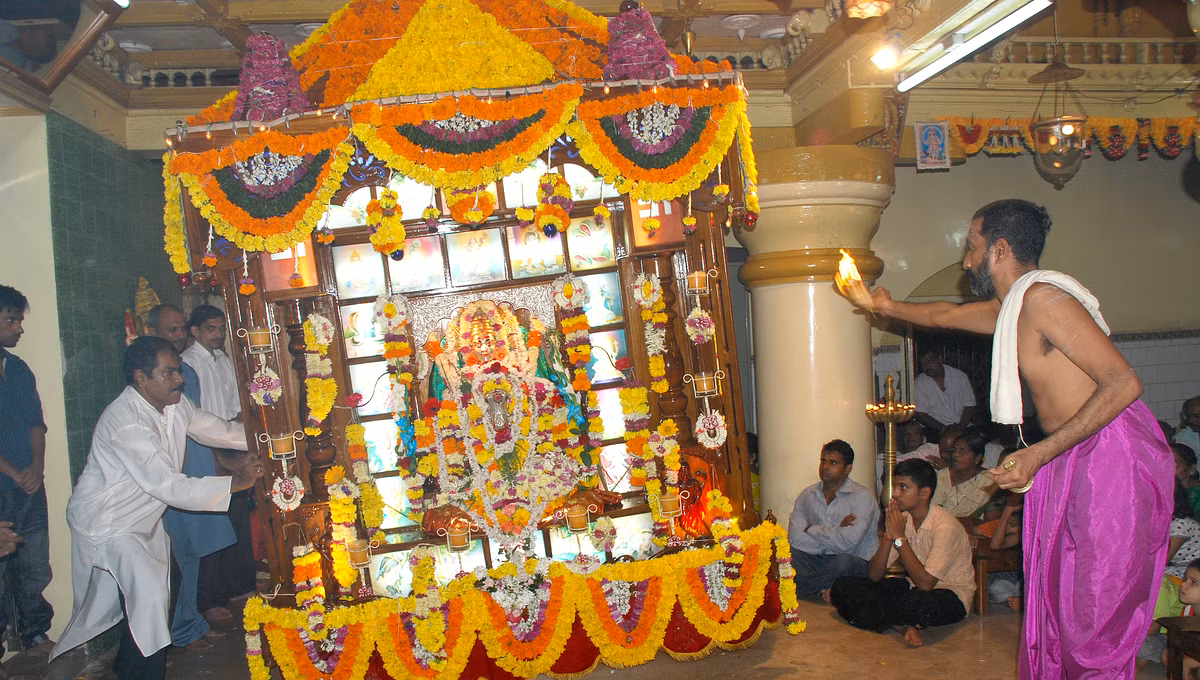
In some temples, the Makharotsav is organised for all the nine days whereas in some cases, it is for five days. The village youths by making use of their skills and talents decorates the square shaped wooden framework with the multi-coloured glittering paper. In the middle of this framework, there lies a seat, on which the goddess is seated.
Bonderam - Age old Festival of Goa at Divar Island
Bonderam a centuries old festival, celebrated on the beautiful island of Divar in Goa epitomizes the essence of the rich cultural heritage using colorful parades of floats, street dancing and music festival. The festival happens in the month of August during the monsoons and before Ganesha Chaturthi. Bonderam derives it's name from Portuguese word, Bondeiras meaning flags.
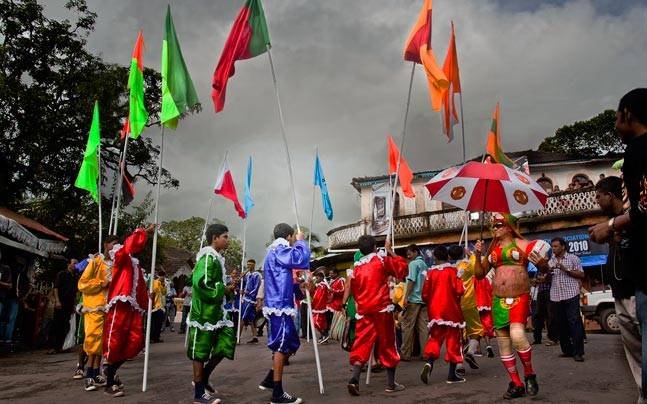
Bonderam is a very popular monsoon festival in Goa. It was believed that during the Portuguese era, the different communities in Divar had frequent disputes over property issues. These often led to violence and fights in the village. To find a solution to this problem, the Portuguese introduced a system of demarcation of boundaries with flags. However it did not sit well with the rival groups as they use to knock down the flags in a protest. As a memory of those protests the festival of Bonderam is celebrated in Divar island.
Homkhand or Homkund Utsav at Chorao Island in Goa
Goa is known for the unique festival of Homkhand celebrated at various places. The festival involves lighting a pyramidal stack of wood that is about five to six feet high. After the wood is burned to cinders, the local men and boys walk barefoot over the hot embers to the beats of local percussion instruments such as dhol, tasha, and cymbals. It's an enthusiastic and awe-inspiring event as over hunderds of people walk on the fire.
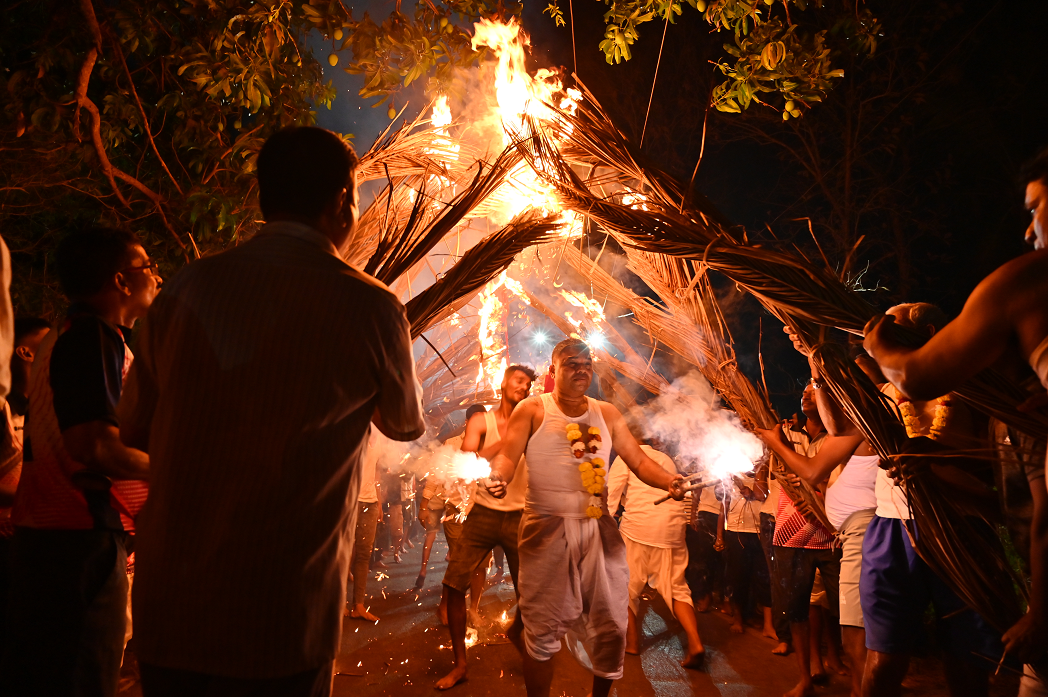
The picture is taken at Homkund Utsav at Madel Chorao island. At Chorao/Chodan island this festival has some more additional rituals. Before lighting the Homkund, huge group villagers light the dried coconut leaves and run in a procession which creates a awe-strucking scene of fire. After that, they light the homkund one by one and later dance around the homkund on the cheerful traditional music and songs.
Veerabhadra - Lord Shiva Dance in Festival of Goa
The fearsome Veerabhadra, a persona of Lord Shiva is honoured once a year by the people of Goa through song and dance. One of Goa's many folk art forms is the Veerbhadra Dance, traditionally performed during the Shigmo festival and Gudi Padwa. This dance is a tribute to Veerbhadra, an attendant of Lord Shiva. To the beats of dhol and kasale, an artist flashes swords as if preparing for a battle, adding a dynamic and intense energy to the performance.
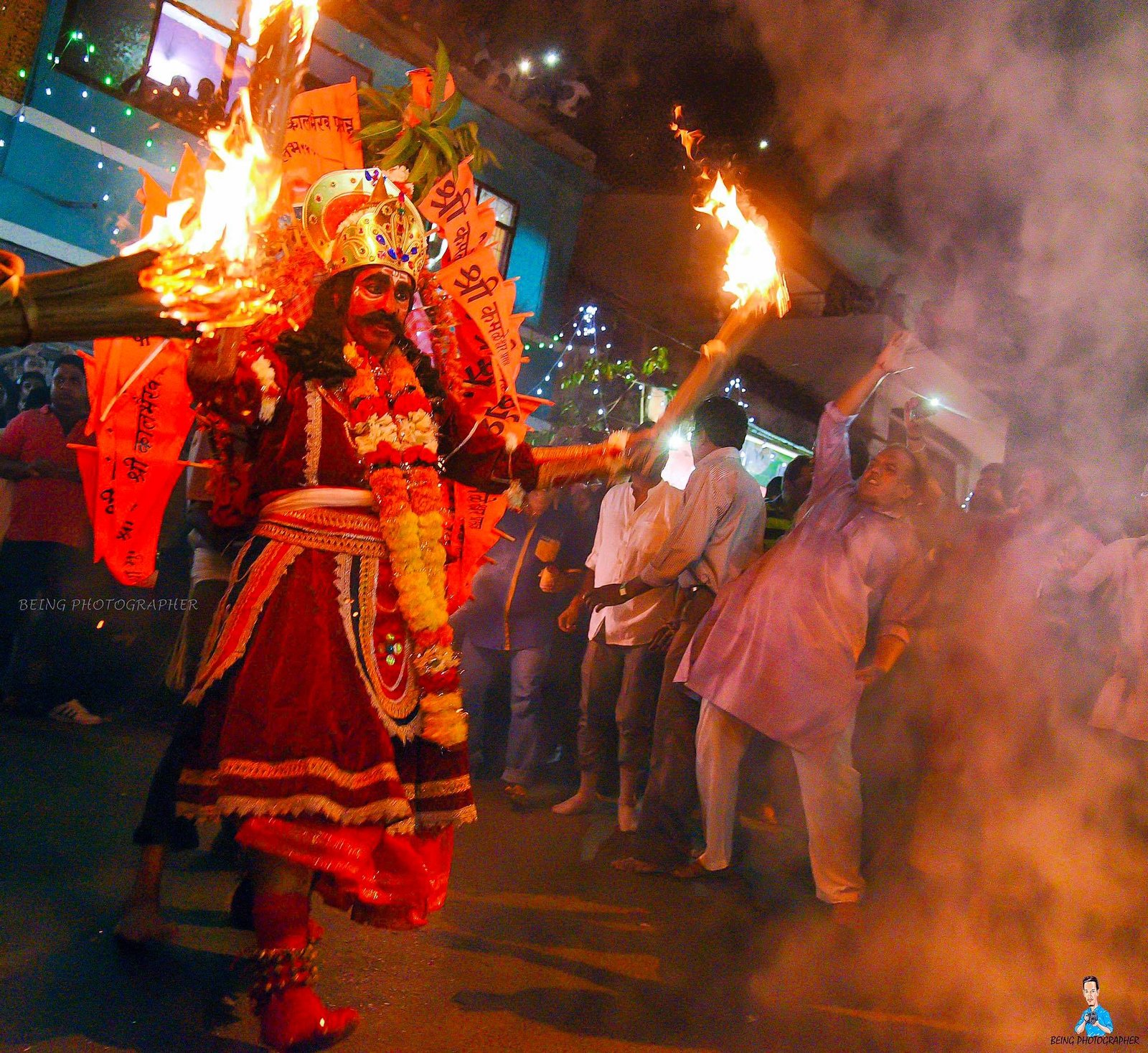
Shidiyo - Balancing Play in Traditional Festival of Goa
In the village of Balli, a ritual called Shidiyo is performed to symbolize penance. This ritual involves erecting a 20-foot pole in the center of the ground and attaching a 30-foot horizontal pole, locally known as laat, to it. The laat is balanced and can hold a man at one end.
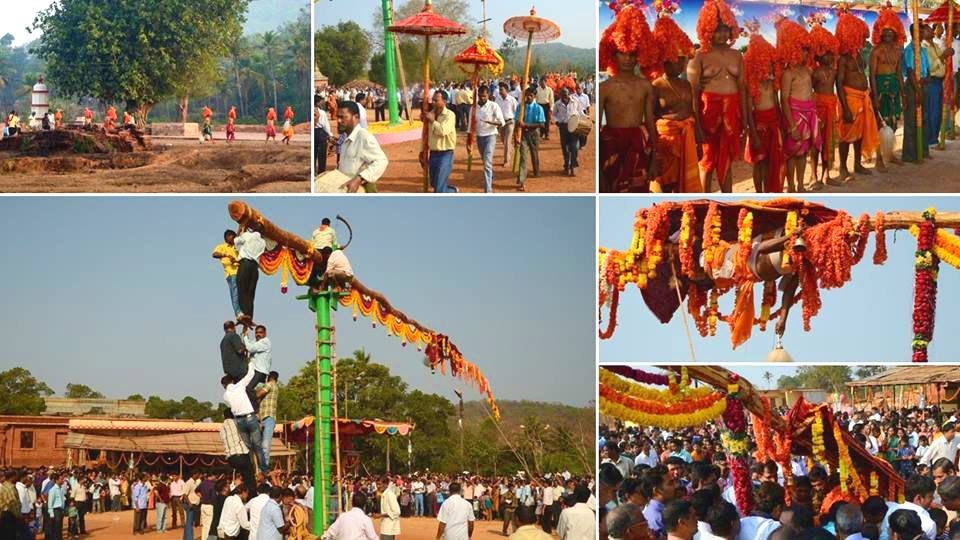
The man, called Gada, who has made a vow or has a defined purpose to keep, is tied face down to the laat. A group of people then hold a rope attached to the other end of the laat to ensure its balance as the laat is rotated five times, alternating between clockwise and counterclockwise rotations. Finally, the Gada is released from the laat, and witnesses of the ritual treat him with great respect, often bowing before him.
Gulalotsav at Zambaulim - Festival of Colors in Goa
The Shree Damodar Temple in Zambaulim is renowned for the vibrant celebration of the gulal festival during the Phalgun month of the Hindu calendar. The festival commences at the Shree Damodar Hall in Margao, which belongs to the Mutt Gram Sansthan Hindu Sabha. There are no exact records as to when the festival began.
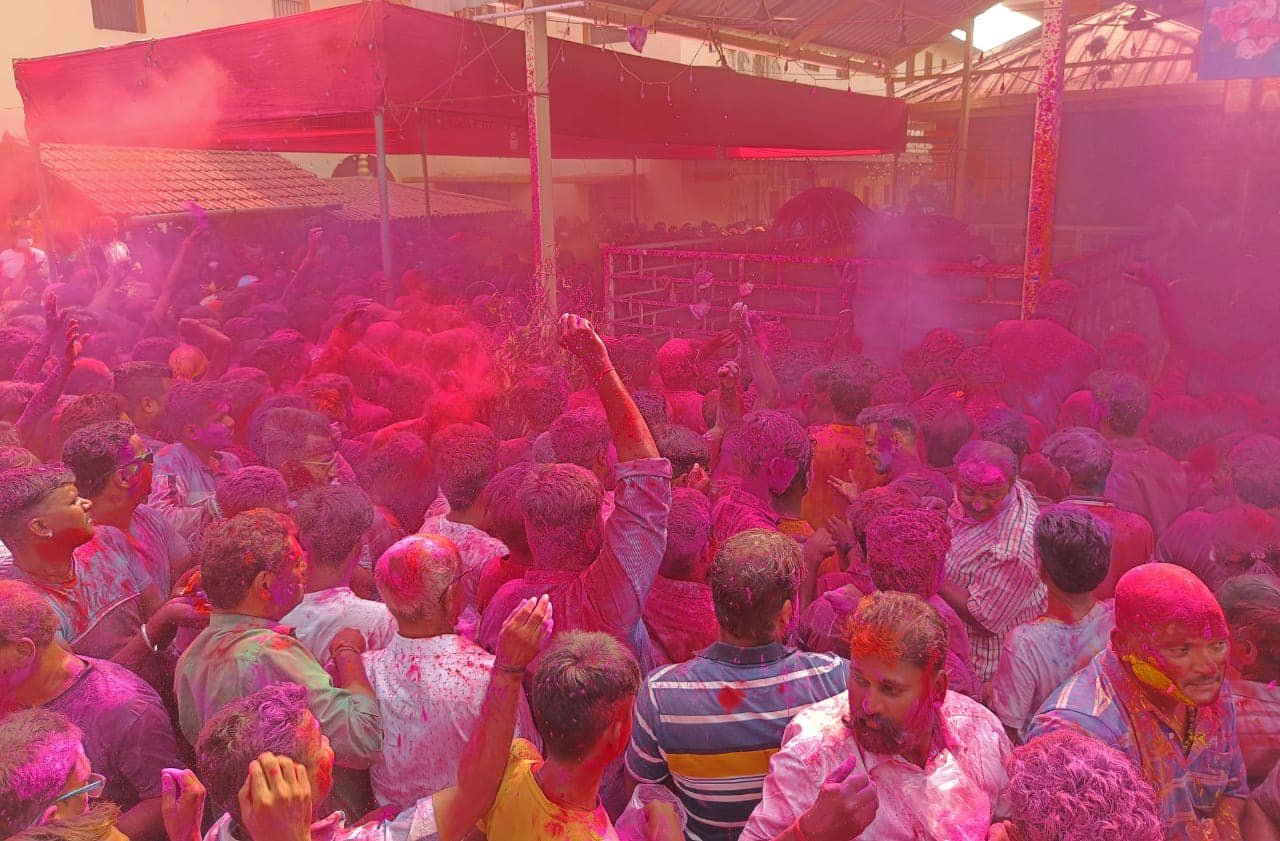
The festival attracts people from all over Goa who come to participate in the celebrations. In the evening, a palki carrying an idol of Lord Damodar is taken out in a procession, with people throwing gulal on the idol as it passes by. Those carrying the palki, as well as the devotees, get covered with gulal, which is considered an auspicious and joyous act during the occasion.
Tripurari Poornima Boat Festival at Vithalapur, Sankhali (Sanquelim)
The festival of Tripurari Pournima or Kartiki Pournima is observed on the fifteenth day of the first fortnight of the Hindu month of Kartika, symbolizing the triumph of good over evil.
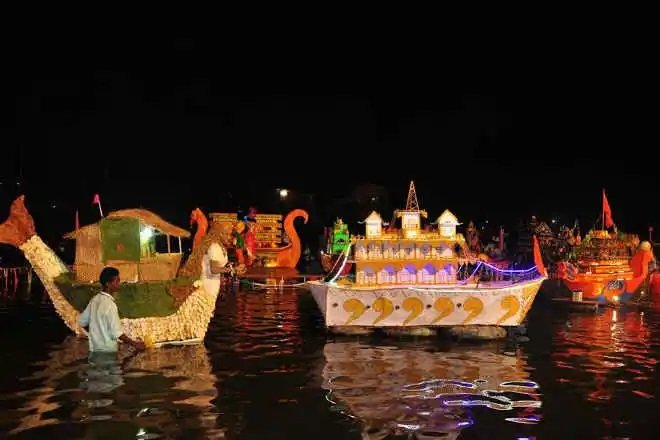
In Vitalapur-Sanquelim, the festival is celebrated annually on the banks of the River Valavanti. The festivities include a procession of Lord Krishna starting at 7 PM, followed by the floating of lamps in the River Valvanti. At 11 PM, the Palakhi procession of Lord Vithal and Goddess Rakhumai arrives, and the symbolic killing of the demon Tripurasur (Tripurasur Wadh) occurs, along with the release of Sarang (a hot air balloon lamp) and fireworks. One of the highlights of the festival is the artistic and decorative models of boats crafted out of cardboard and thermocol that float in the river at midnight.
These are just a few of the many rare and unique festivals that are celebrated in Goa, and each festival reflects the cultural diversity and richness of the state.
Do you wish to witness these amazing festivals of Goa? Come with us!
We at Hinterscapes take you to a Goa tour from a different angle. Goa is beyond beaches and night life. Visit our website and book your most affordable package which will give you a Goan feel of anything you do. Experience the real magic of Hinterland tourism in Goa.
Suggested Read: Monsoon Festivals to Witness in Goa in 2023
Don’t forget to follow us on Instagram, Facebook and YouTube to watch few amazing videos of amazing trails of unseen places of Goa. So, stay tuned to our blog to read more of such interesting articles about Goa.
Please tell us in comments how you felt about this article.

